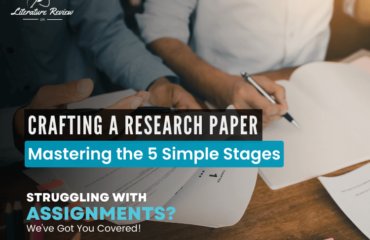
Introduction: Embarking on a literature review can be both exhilarating and daunting. It’s a journey through the vast expanse of existing knowledge, a chance to explore, analyze, and synthesize what others have discovered. But fear not, for in this comprehensive guide, we’ll unlock the secrets of literature review writing, providing you with invaluable tips, techniques, and examples to navigate this scholarly landscape with confidence.
Guide to Writing a Literature Review: At the heart of academic inquiry lies the literature review, a critical examination of existing scholarship on a particular topic. Whether you’re a seasoned researcher or a beginner, crafting a literature review can be a challenging yet rewarding endeavor. Here’s a step-by-step guide to help you navigate the process with ease.
Step 1: Define Your Scope Before diving into the sea of literature, it’s crucial to define the boundaries of your review. Clarify your research question or thesis statement to guide your exploration and ensure relevance and focus in your review.
Step 2: Conduct Thorough Research Armed with a clear focus, delve into academic databases, journals, books, and other reputable sources relevant to your topic. Use keywords and search terms strategically to uncover relevant literature that will inform your review.
Step 3: Evaluate and Analyze As you gather sources, critically evaluate each one for its relevance, credibility, and significance to your research question. Analyze the key arguments, methodologies, and findings of each study, identifying patterns, gaps, and contradictions in the literature.
Step 4: Synthesize and Organize Once you’ve reviewed a substantial body of literature, synthesize the findings, identifying common themes, debates, and areas of consensus or disagreement. Organize your review thematically, chronologically, or methodologically, depending on what best suits your topic and argument.
Literature Review Structure and Examples: A well-structured literature review provides a roadmap for readers, guiding them through the complexities of existing research while highlighting the significance of your contribution. Here’s a typical structure for a literature review, along with examples to illustrate each section.
- Introduction:
-
- Provide an overview of the topic and its significance.
- Define key terms and concepts.
- State the purpose and scope of the literature review.
Example: “In this literature review, we explore the evolving role of artificial intelligence (AI) in healthcare, examining its impact on patient outcomes, diagnostic accuracy, and healthcare delivery.”
- Body:
-
- Organize the literature thematically, chronologically, or methodologically.
- Discuss key findings, debates, and trends in the literature.
- Critically analyze and evaluate each source.
Example: “Theme 1: The Impact of AI on Patient Outcomes
- Study 1: Smith et al. (2019) found that AI-assisted diagnostic tools improved early detection rates of cancer by 20%.
- Study 2: However, Jones et al. (2020) raised concerns about the overreliance on AI algorithms, citing instances of misdiagnosis.”
- Conclusion:
- Summarize the key findings and insights from the literature.
- Identify gaps in the research and areas for future investigation.
- Reiterate the significance of the topic and your contribution to the field.
Example: “In conclusion, while AI shows promise in revolutionizing healthcare, more research is needed to address ethical, regulatory, and practical challenges. This literature review lays the groundwork for further exploration into the transformative potential of AI in improving patient care.”
Writing a Literature Review for Beginners: For novice researchers, writing a literature review can seem like a daunting task. However, with the right approach and guidance, you can navigate this process successfully. Here are some tips to help you get started on your literature review journey.
Tip 1: Start Early and Stay Organized Begin your literature review well in advance of your deadline to allow ample time for research, analysis, and writing. Create a systematic plan or outline to guide your progress and keep track of your sources and notes.
Tip 2: Read Widely and Critically Cast a wide net in your literature search, exploring diverse sources and perspectives relevant to your topic. Be discerning in your selection, critically evaluating each source for its quality, relevance, and credibility.
Tip 3: Take Notes and Annotate As you read, take detailed notes and annotate your sources to capture key ideas, arguments, and evidence. Organize your notes by theme or category to facilitate synthesis and analysis later on.
Tip 4: Seek Feedback and Revise Don’t hesitate to seek feedback from peers, mentors, or instructors as you draft your literature review. Incorporate constructive criticism and revisions to strengthen your argument and clarity.
Literature Review Format and Examples: Formatting your literature review correctly is essential for clarity, coherence, and adherence to academic conventions. Here’s a basic format to follow, along with examples to illustrate each element.
- Title:
-
-
- Provide a clear and descriptive title that reflects the focus of your literature review.
- Example: “The Role of Social Media in Shaping Political Discourse: A Literature Review”
-
- Introduction:
-
-
- Introduce the topic and its significance.
- State the purpose and scope of the literature review.
- Example: “In recent years, social media platforms have emerged as powerful tools for shaping public opinion and political discourse. This literature review examines the impact of social media on political communication and participation.”
-
- Body:
-
-
- Organize the literature thematically, chronologically, or methodologically.
- Discuss key findings, debates, and trends in the literature.
- Example: “Theme 1: The Influence of Social Media on Voter Behavior
- Study 1: Smith et al. (2018) found that exposure to political content on social media increased voter engagement and political participation.
- Study 2: However, Jones et al. (2019) argued that social media algorithms amplify echo chambers and polarization, leading to decreased trust in political institutions.”
-
- Conclusion:
-
- Summarize the key findings and insights from the literature.
- Identify gaps in the research and areas for future investigation.
- Example: “In conclusion, while social media has the potential to enhance political discourse and participation, it also poses challenges in terms of misinformation and polarization. This literature review highlights the need for further research to address these complex issues.”
Easy Steps to Write a Literature Review: Writing a literature review doesn’t have to be overwhelming. By breaking down the process into manageable steps, you can tackle each stage with confidence and clarity. Here are some easy steps to guide you through writing your literature review.
Step 1: Define Your Objectives Clarify the purpose and scope of your literature review, identifying the key research question or thesis statement that will guide your exploration.
Step 2: Conduct Thorough Research Gather relevant sources from academic databases, journals, books, and other reputable sources, using keywords and search terms to narrow your focus.
Step 3: Evaluate and Analyze Critically evaluate each source for its relevance, credibility, and significance to your research question. Analyze the key arguments, methodologies, and findings of each study.
Step 4: Synthesize and Organize Synthesize the findings of your literature review, identifying common themes, debates, and trends in the literature. Organize your review thematically, chronologically, or methodologically to provide a coherent narrative.
Literature Review Writing Techniques: Crafting a compelling literature review requires more than just summarizing existing research. It demands careful attention to detail, critical analysis, and effective synthesis of ideas. Here are some techniques to help you elevate your literature review writing:
Technique 1: Engage with the Literature Don’t just passively summarize each source. Engage critically with the material, interrogating the authors’ arguments, methodologies, and evidence. Look for connections between different studies and identify areas of agreement or disagreement.
Technique 2: Provide Context and Significance Situate each source within the broader scholarly conversation. Explain why the research is relevant to your topic and how it contributes to our understanding of the subject. Highlight any gaps or limitations in the existing literature that your study aims to address.
Technique 3: Use Clear and Concise Language Avoid jargon and overly complex language that might alienate readers. Aim for clarity and precision in your writing, using straightforward language to communicate your ideas effectively. Break down complex concepts into digestible chunks and provide clear explanations where necessary.
Technique 4: Synthesize with Purpose Synthesis is more than just summarizing multiple sources. It involves integrating diverse perspectives and findings to generate new insights or perspectives. Aim to synthesize the literature in a way that adds value to the conversation, offering fresh interpretations or solutions to existing problems.
Examples of Literature Reviews for Assignments: To illustrate the principles and techniques discussed above, let’s explore two examples of literature reviews written for academic assignments.
Example 1: Literature Review on Climate Change Adaptation Strategies Introduction: Climate change poses unprecedented challenges to human societies and ecosystems, necessitating urgent adaptation measures. This literature review examines the effectiveness of various adaptation strategies in mitigating the impacts of climate change on vulnerable communities.
Body: Theme 1: Community-Based Adaptation Approaches
- Study 1: Smith et al. (2017) conducted a case study of a community-based adaptation project in Bangladesh, highlighting the importance of local knowledge and participation in designing effective resilience strategies.
- Study 2: Jones et al. (2018) assessed the role of social networks in facilitating community-based adaptation in rural African communities, emphasizing the importance of collective action and social cohesion.
Theme 2: Technological Solutions for Climate Resilience
- Study 3: Johnson et al. (2019) evaluated the efficacy of innovative technologies such as climate-smart agriculture and early warning systems in enhancing adaptive capacity and reducing vulnerability to climate-related disasters.
- Study 4: Brown et al. (2020) explored the potential of nature-based solutions such as green infrastructure and ecosystem restoration in building climate resilience at the local and regional levels.
Conclusion: In conclusion, while community-based approaches and technological solutions offer promising avenues for climate adaptation, more research is needed to assess their long-term effectiveness and scalability. This literature review underscores the importance of interdisciplinary collaboration and stakeholder engagement in developing holistic adaptation strategies.
Example 2: Literature Review on Mental Health Interventions for Adolescents Introduction: Adolescence is a critical period of development marked by unique challenges and vulnerabilities, including mental health issues. This literature review examines the efficacy of various interventions aimed at promoting mental well-being and resilience among adolescents.
Body: Theme 1: Cognitive-Behavioral Therapy (CBT) Approaches
- Study 1: Smith et al. (2016) conducted a meta-analysis of CBT-based interventions for adolescent depression, demonstrating significant reductions in depressive symptoms and improved coping skills.
- Study 2: Jones et al. (2017) evaluated the effectiveness of online CBT programs in reducing anxiety symptoms and increasing access to mental health support among adolescents in underserved communities.
Theme 2: Mindfulness-Based Interventions
- Study 3: Johnson et al. (2018) investigated the impact of mindfulness training on stress reduction and emotional regulation in adolescents, finding promising results in improving overall well-being and resilience.
- Study 4: Brown et al. (2019) explored the feasibility of integrating mindfulness practices into school-based curricula, highlighting the potential benefits for enhancing emotional intelligence and self-awareness.
Conclusion: In conclusion, while CBT and mindfulness-based interventions show promise in promoting adolescent mental health, more research is needed to understand their long-term effects and mechanisms of action. This literature review emphasizes the importance of early intervention and holistic approaches that address the multifaceted nature of adolescent well-being.
Conclusion: In the vast landscape of academia, the literature review serves as a compass, guiding scholars through the terrain of existing knowledge and illuminating paths for future exploration. By mastering the art of literature review writing, researchers can engage meaningfully with the scholarly conversation, contributing new insights and perspectives to their respective fields.
As you embark on your own literature review journey, remember the tips, techniques, and examples shared in this guide. Whether you’re a beginner or seasoned researcher, crafting a literature review that is rigorous, insightful, and compelling is within your reach. So go ahead, dive into the literature, unlock its secrets, and let your voice be heard in the ongoing dialogue of ideas.
If you found this guide helpful or have any questions, feel free to leave a comment below. We’d love to hear from you and continue the conversation!




